image by António Martins, 08 Dec 2005 |

Last modified: 2005-12-24 by antonio martins
Keywords: dimensions | construction | hammer and sickle | different reverse |
Links: FOTW homepage |
search |
disclaimer and copyright |
write us |
mirrors
 image by António Martins, 08 Dec 2005 | |
Reverse side of the soviet flag (at least since 1977) was plain red.
Victor Lomantsov, 08 Nov 2001
According to the Soviet Constitution of 1980, the reverse is plain red. This is actually expliceted not on the text (which is scarce in construction details) but on the color plate and on the b/w construction sheet, that shows the obverse with the h&s+star device on the top hoist and the obverse completely red (obverse and reverse are illustrated by showing a spearpointed pole: obverse shows the pole at the viewer’s left hand and the reverse shows the pole at the viewer’s right hand).
Please note that this is so in the 1980 version of the constitution, but it doesn’t meant that this was not taken without change from previous versions. So the soviet flag might have had a plain red background before 1980 (and probably it did). The colour plate (on whose backside is printed the b/w construction sheet) is said to have been published by decree of the Preasidium of the Supreme Soviet on 1980.08.15, although the preambulum of the Constitution (whose section VIII deals with the arms, flag, anthem and capital of the Soviet Union), was approved on 1977.10.07.
António Martins, 10 Dec 1999
No hammer, sickle and star on reverse side
[applies to all SSRs’
flags and their derivatives].
Mark Sensen, 25 May 1997
The USSR flag had in front a hammer and sickle and the back was a plain red flag with nothing on it. I’ll admit that I had a bit of trouble finding a written reference again when I needed it, but from Webster’s Concise Encyclopedia of Flags & Coats of Arms [mch85a]:
The flag was approved in 1923 and finally settled in 1924; the shape of the hammer and sickle was slightly corrected and exactly prescribed in 1955. In 1980 it was stipulated that the hammer, the sickle and the star appear only on the obverse side of the flag, the reverse being all red.I’ve seen (and probably own) flags made following this regulation and others ignoring it completely.
Not all the SU flag were made according to those specifications, so I
am sure that there would be some found with H&S on reverse too.
Željko Heimer, 08 Nov 2001
In May 1985, I accompanied my brother on a California lawyers two
week continuing education tour of four cities in the Soviet Union (Moscow,
Minsk, Kiev, and Leningrad). In all those places, of course flags were in
evidence. And we were in the crowd of foreigners in from of the Hotel
Metropole for the 9th May Victory Day Parade,
where flags were more than numerous. Also, a boat trip on the Dneiper in
Kiev, the crowded Space Park across from the Hotel Kosmos in Moscow, war
memorials in Mink and Kiev (“The Mother of the Ukraine”,
an amazing statute), at the Hermitage and Puskin Museum in Leningrad, in
all those places many flags. In the Space park was a display of 16 poles
flying the Union Flag, as well as the 15 Republic Flags. But
nowhere did I see a flag flying as described above, with the symbols
on only one side. I have no doubt that while the above description is
correct, it was ignored by state institutions of every type.
John Crosby, 17 May 2001
a: width of hammer and sickle;
b: height of hammer and sickle;
c: space between top of hammer and sickle and centre of star;
d: diametre of circle inscribing star;
e: height of the hammer;
f: distance from centre of star to top of flag;
g: distance from centre of hammer-and-sickle and star to hoist
(All measurements in fractions of the heigth of the flag.
In brackets, values not expressed but deduced, calculated or
implied)
| a | b | c | d | e | f | g | sources | |
|---|---|---|---|---|---|---|---|---|
| Soviet Union | 1/4 | 1/4 | 1/16 | 1/8 | 1/8 | 1/3 | ||
| Kazakhstan | 1/4 | (1/16) | 1/8 | 1/2 | [fss] | |||
| Russia | 1/4 | (1/16) | 1/8 | 2/5 | [lau97] | |||
| Tadzhikstan | 1/4 | 1/4 | (1/20) | 1/10 | 1/10 | 1/3 | ||
| Turkmenistan | 1/6 | (1/20) | 1/10 | 1/10 | 1/4 | [fss] | ||
| Uzbekistan | 1/5 | (1/20) | 1/10 | 1/10 | 1/3 | [sol85] | ||
| Ukraine | 1/4 | 1/4 | (1/16) | 1/8 | 3/16 | 1/8 | 2/3 | [sol83] |
![[generic h&s construction sheet]](../images/s/su'hs.gif)
The hammer an sickle device is enscribed in a square, the handles of
both instruments placed on it’s diagonals, and the tip of the sickle
coinciding with the middle of the upper side of the said square. The star
(whose fimbriation is not defined in this construction sheet, as also the
details of the hammer and sickle), is inscribed on a cicle, which is
tangent to the said square also on the middle point of it’s upper side.
There may be a more detailed construction sheet giving the missing details,
but it is not included on the 1980 version of the constitution.
António Martins, 09 Dec 1999
No hammer, sickle and star on reverse side.
Mark Sensen, 25 May 1997
One thing I note on this is that the width of the
yellow fimbriation of the star is not defined!
Željko Heimer, 24 May 1997